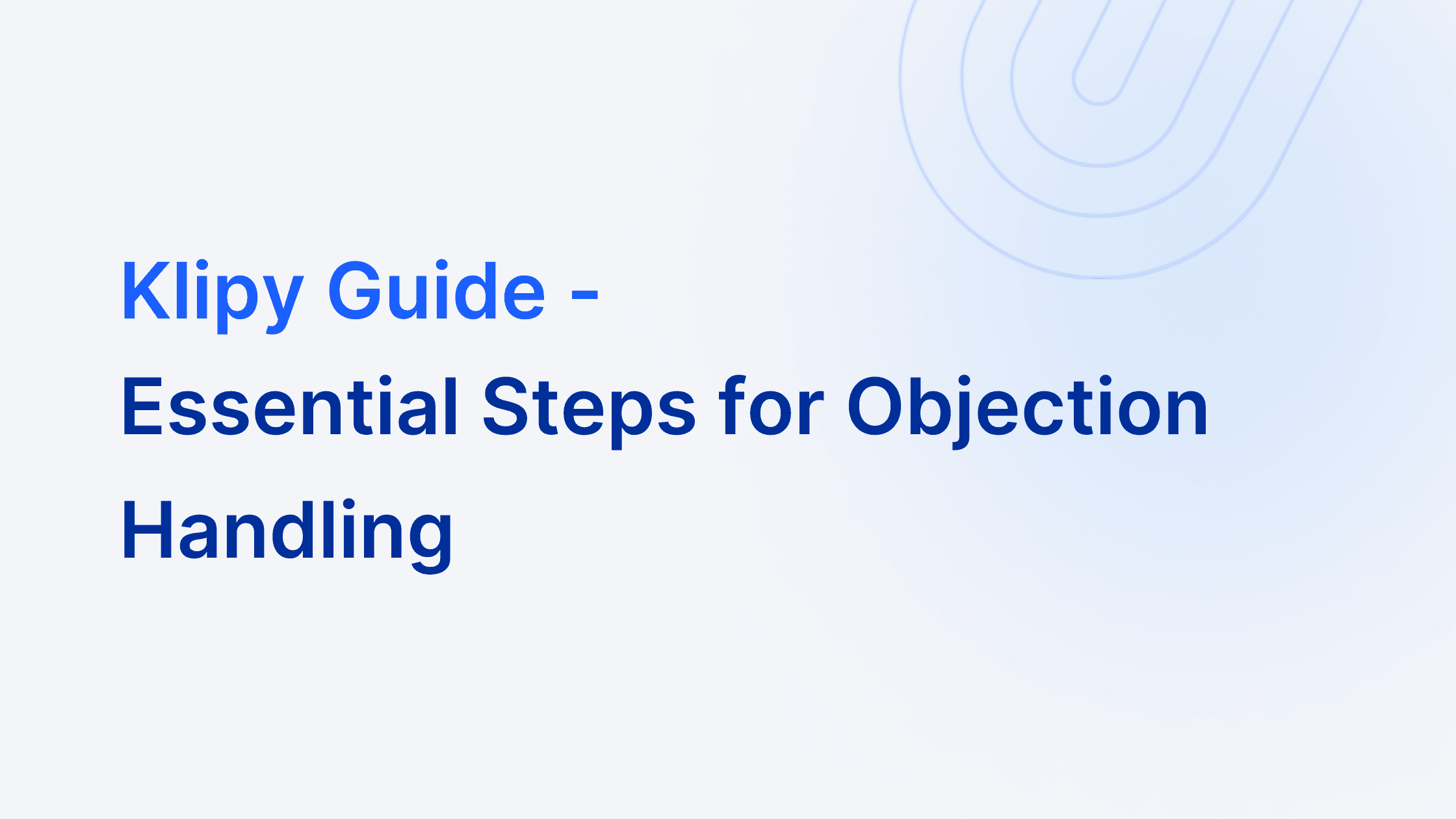Sales
16 Conversation Starters for Any Situation
Master the art of conversation starters to break the ice and build connections across any scenario. Uncover key strategies for virtual and face-to-face interactions.
Why Conversation Starters Matter
Ever been in a room full of people, unsure what to say? Or in a virtual meeting, feeling the awkward silence? Conversation starters can break the ice and ease these moments.
With the right words ready, you can connect with people more easily. It's about building relationships and making discussions engaging and productive. Having a few conversation starters on hand helps in various situations, from networking events to virtual meetings.
You're at a networking event. You've got your elevator pitch down, but how do you start a meaningful conversation? Or maybe you're leading a virtual meeting. You want to get everyone talking, but how do you kick things off? That's where good conversation starters come in.
These openers help you navigate different scenarios with confidence. You'll avoid those awkward silences where you're searching for what to say next. Instead, you'll be ready to dive into engaging discussions that can lead to new opportunities and stronger connections. Let's explore some tips and examples to improve your conversation skills.
Icebreakers for Virtual Meetings
Engaging Questions for Networking Events
Networking events can be a bit nerve-wracking. Standing there, trying to figure out how to break the ice without sounding awkward. This is where having some go-to questions can really save the day. It's all about making genuine connections and showing interest in the person you're talking to.
What should you ask? Here are some ideas:
What inspired you to get into your field?: This question can open up a wealth of stories and insights about their career journey.
How do you stay updated with industry trends?: It's a great way to share resources and learn from each other.
What projects are you currently working on?: Everyone loves talking about their work, and it gives you a chance to find common ground.
What do you enjoy most about your job?: This can lead to a positive and engaging conversation.
What are some challenges you're facing in your role?: It shows empathy and can lead to a deeper discussion.
Networking is about more than just exchanging business cards. It's about building relationships. When you ask these questions, listen to the answers. Show that you're genuinely interested.
Following up with more questions based on their responses keeps the conversation flowing naturally. For example, if they mention a project, ask about the specifics or how they manage their tasks. If they talk about challenges, share how you tackle similar issues. For instance, if they discuss difficulties in managing customer relations, you could mention how implementing a Customer Relationship Management (CRM) system has been beneficial, and share insights from signs your small business needs a CRM.
Networking events don't have to be daunting. With these questions, you'll be ready to start meaningful conversations that could lead to valuable connections.
Keeping Discussions on Track
Keeping discussions on track is crucial. It's easy for conversations to veer off-topic. Here are some strategies to keep things focused and productive.
First, paraphrasing helps. Repeat what the other person said in your own words to show you're listening. It also helps clarify points. For example, "If I understand correctly, you're saying..."
Second, use bridging. Link what was said to the main topic. If someone goes off on a tangent, say something like, "That's interesting and actually ties into our main point about..."
Another handy tool is linking ideas. Connect different parts of the conversation to maintain flow. For example, "That reminds me of what we discussed earlier about..."
When conversations stray, gently steer them back. Use phrases like, "Let's circle back to..." or "I think we were focusing on..."
Summarizing key points is also effective. Recap the main points periodically to keep everyone aligned. For instance, "So far, we've covered..."
Asking follow-up questions keeps the discussion relevant. It shows interest and keeps the conversation moving. For example, "How does that impact our current project?"
These techniques ensure that discussions stay on track. Everyone stays engaged, and the conversation remains relevant. You'll find that using these strategies makes your meetings more productive and enjoyable. For more insights on enhancing productivity and customer engagement, you might find our article on must-have CRM features for startup founders particularly useful.
Dealing with Difficult Conversations
Difficult conversations happen. Managing them effectively is key. Setting expectations and ground rules at the outset can help. Start by outlining the purpose of the conversation and what you hope to achieve. This sets a clear direction.
When things get tricky, it's important to stay calm. Use inclusive language to keep everyone engaged and reduce tension. Here are some techniques to manage disruptive discussions:
Paraphrasing: Repeat disruptive comments in your own words. This shows you're listening and helps clarify misunderstandings. For example, "You're saying that..."
Redirection: Steer the conversation back on track. If someone goes off-topic, say something like, "I see your point, but let's get back to..."
Empathy Statements: Acknowledge emotions without getting sidetracked. "I understand this is frustrating, but let's focus on finding a solution."
Another useful tactic is setting boundaries. If someone is monopolizing the conversation, gently interrupt with, "Let's hear from others too." This ensures everyone gets a chance to speak. For teams looking to enhance their collaborative efforts and streamline operations, Klipy offers a collaborative CRM designed to enhance team dynamics and streamline sales operations with maximum transparency and efficiency.
Using these techniques keeps the conversation productive. Stay composed, and you'll navigate difficult discussions with ease. Remember, the goal is to resolve issues and maintain positive relationships.
Creative Conversation Starters
Ever tried sparking a conversation with a creative exercise? It can be a game-changer, especially in sales or customer interactions. Using creative conversation starters helps break the ice and encourages self-expression. Let's dive into some examples.
Imagine starting your day with morning pages. This exercise involves writing a few pages of whatever comes to mind first thing in the morning. It's a great way to clear your head and can be a fantastic conversation starter. Ask someone, "Have you ever tried morning pages? What do you think about them?" This opens up a dialogue about creative habits and personal routines.
Another idea is guided writing. This involves writing prompts to spark creativity. You could ask, "If you could have dinner with any historical figure, who would it be?" or "What's the most interesting thing you've learned recently?" These questions not only get people talking but also thinking creatively.
Here are some more creative questions to try:
What are you most excited about right now?: This question is great for tapping into someone's current passions and projects.
If you could master any skill instantly, what would it be?: This can lead to fascinating discussions about personal goals and interests.
What's your favorite way to unwind after a busy day?: It’s a personal touch that shows you care about their well-being.
If you could travel anywhere in the world, where would you go and why?: This opens up conversations about travel dreams and cultural interests.
These conversation starters do more than just fill the silence. They help clarify thoughts, reduce anxiety, and bring out creativity. Encouraging self-expression in conversations makes interactions more meaningful and engaging. For more tips on enhancing your sales strategies, check out our ultimate lead generation glossary, which provides a comprehensive overview of essential terms crucial for mastering lead generation and nurturing strategies.
Give these a try in your next meeting or networking event. You'll be surprised at how they transform the dynamic and lead to deeper connections.
Using Nonverbal Cues
Nonverbal communication plays a huge role in virtual settings. Even though you're not physically present, your body language, eye contact, and vocal tone can make a big difference in how you're perceived.
Eye contact is crucial, but how do you achieve that in a virtual meeting? Simple—look into the camera when speaking. It might feel weird at first, but it creates the illusion of direct eye contact, making your audience feel more connected.
Your vocal tone also matters. Speak clearly and vary your tone to keep people engaged. A monotone voice can make even the most interesting subject sound dull. Throw in some enthusiasm and watch how it changes the dynamic.
Open body language is another key element. Sit up straight, avoid crossing your arms, and use hand gestures when appropriate. These small actions can make you appear more approachable and engaged.
Here are some quick tips to enhance your nonverbal communication:
Look into the camera: This mimics eye contact and helps create a connection.
Use your hands: Gestures can emphasize your points and make you look more animated.
Vary your tone: A dynamic vocal range keeps people interested.
Mind your posture: Sitting up straight shows that you're attentive and engaged.
Smile: A genuine smile can make you seem friendly and approachable.
One technique that works wonders is 'Virtual Applause.' Encourage participants to use reaction emojis or clap their hands on camera. This fosters a sense of presence and engagement, even through a screen.
Nonverbal cues might seem minor, but they can significantly impact your virtual interactions. Try these tips in your next meeting and notice the difference in engagement and connection.
Preparing for Virtual Presentations
Virtual presentations are a different beast. Knowing your audience and setting clear goals are key. Start by understanding who you're talking to. Are they experts in the field or newbies? Tailor your content accordingly.
Next, set your goals. What do you want to achieve with this presentation? Are you looking to inform, persuade, or entertain? Having a clear objective will help guide your structure.
Plan your presentation's flow. Break it into digestible chunks. Start with an engaging introduction, followed by the main points, and wrap up with a strong conclusion. Use bullet points to keep things clear.
Familiarize yourself with the technology. Make sure you know how to use the platform's features. Test your mic, camera, and screen-sharing options beforehand. Nothing kills the vibe like technical difficulties.
Create engagement with 'Quick Chat' questions. These are short, simple questions to get people talking. For example, "What's one thing you're hoping to learn today?" It gets everyone involved right from the start.
Maintain energy with 'Virtual Applause'. Encourage participants to use reaction emojis or clap their hands on camera. This keeps the energy up and makes the virtual space feel more dynamic.
Here are some quick tips:
Know Your Audience: Understand their background and tailor your content.
Set Clear Goals: Define what you aim to achieve.
Plan Your Structure: Break your presentation into clear, manageable sections.
Test Your Tech: Make sure everything works smoothly.
Use 'Quick Chat' Questions: Engage participants from the get-go.
Encourage 'Virtual Applause': Keep the energy and engagement high.
By following these steps, you'll deliver a more engaging and effective virtual presentation. You'll keep your audience hooked and your message clear.
Building a Sense of Community
Creating a sense of community in virtual meetings is essential. It helps people feel connected and engaged. Here’s how to make it happen.
Use inclusive language. Address everyone and make sure no one feels left out. Phrases like "What does everyone think?" or "Let's hear your thoughts" encourage participation.
Acknowledge contributions. When someone shares an idea, validate it. Say things like, "That's a great point, thanks for sharing," or "I appreciate your input." This makes people feel valued.
Virtual Applause works wonders. Encourage participants to use reaction emojis or give a thumbs-up on camera. It creates a sense of presence and shows appreciation.
Here are some engagement techniques:
Quick Polls: Use polls to get instant feedback. Ask simple questions like, "Do you agree with this?" It keeps everyone involved.
Breakout Rooms: Split into smaller groups for discussions. It allows more intimate conversations and makes everyone feel heard.
Interactive Tools: Use platforms that offer whiteboards or shared documents. It allows everyone to contribute actively.
Clear instructions are crucial. Make sure everyone knows what’s expected. Outline the meeting’s purpose and goals at the start. It sets the tone and keeps things focused.
Validate participants' input. Repeat what they’ve said to show you’re listening. For example, "What you're saying is..."
These strategies build a dynamic and interactive space. People feel more connected and are more likely to engage. A strong sense of community makes virtual meetings more productive and enjoyable.
Connecting Ideas and Participants
Being a moderator or facilitator is more than just keeping time. It's about connecting ideas and participants to create a cohesive discussion. You need to paraphrase key points and link them to the main themes. This helps everyone see how their contributions fit into the bigger picture.
Use inclusive language to make everyone feel part of the conversation. Phrases like "Let's hear from everyone" or "What are your thoughts?" encourage participation. It shows you value each person's input.
Nonverbal cues are also crucial. Look directly at the camera in virtual settings to mimic eye contact. Use gestures to emphasize points and maintain an open posture to appear approachable. These small actions can make a big difference in how connected participants feel.
Here are some tips to keep discussions focused and inclusive:
Paraphrase key points: Repeat what someone said in your own words. This shows you're listening and helps clarify. For example, "So you're saying that..."
Link ideas: Connect different parts of the conversation. Say, "That ties into what we discussed earlier about..."
Summarize periodically: Recap main points to keep everyone on track. For instance, "We've covered..."
Use inclusive language: Encourage everyone to contribute. Ask, "What does everyone think about this?"
Nonverbal cues: Look at the camera, use gestures, and keep an open posture.
By using these strategies, you help create a dynamic and connected discussion. Participants feel heard, and the conversation stays relevant and productive.
Key Takeaways
Good conversation starters are key. They break the ice, ease awkward moments, and build real connections. No matter where you are - a Zoom call, a mixer, or a tough talk - it's best to be ready.
For virtual meetings, ask about new hobbies or weekend plans. This helps everyone relax and connect. It sets a good mood for the meeting.
At networking events, ask about career inspiration or current projects. Show real interest and find common ground. This builds stronger relationships.
In tough talks, take a deep breath and stay focused. Try repeating what they said, changing the subject if needed, or showing you understand. This keeps things on track and friendly.
Creative starters, like asking about favorite ways to unwind or travel dreams, can spark great talks. These help people open up and leave a lasting impression.
Body language matters too. Look into the camera, change your tone, and use open body language in virtual chats. These small actions make you seem more engaged and approachable.
If you're leading the talk, connect the dots between what people are saying. Rephrase key points and use inclusive language. This keeps everyone involved and on topic.
Overall, knowing how to start and guide talks is a big help. It lets you handle different scenarios with confidence, create better interactions, and build stronger connections.
More from the blog








